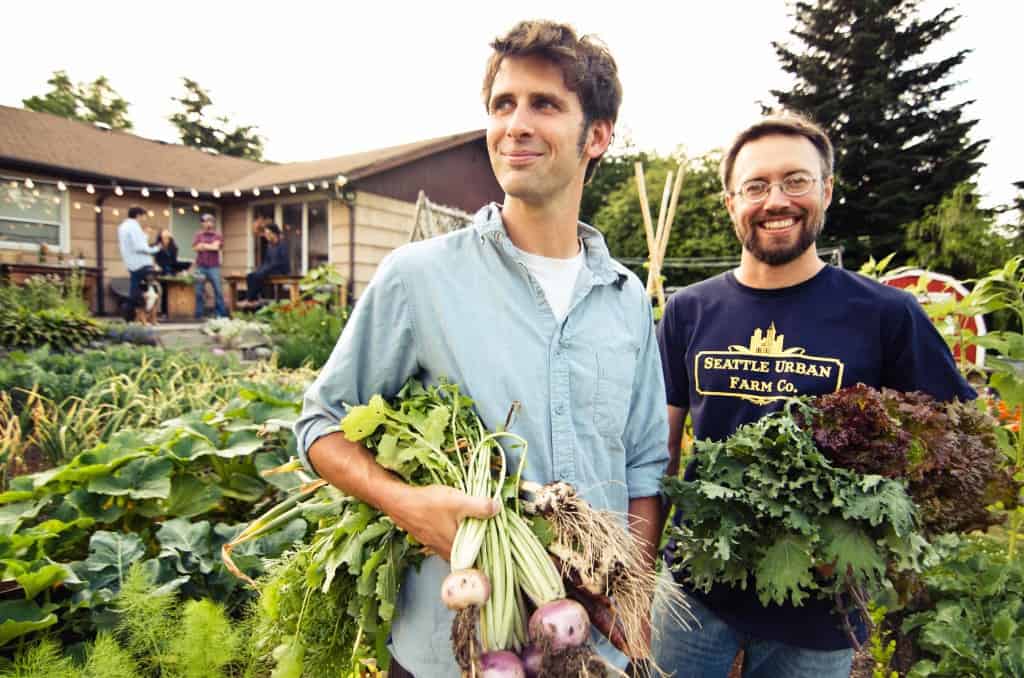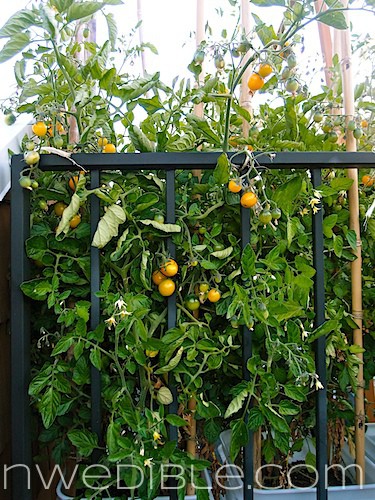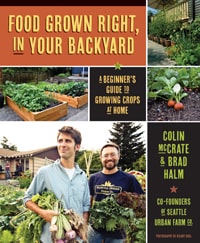In the Seattle urban farming scene, there are a couple of guys – Colin and Brad – who seem to be everywhere. They run the aptly named Seattle Urban Farm Company, and under that moniker set-up and maintain edible gardens in backyards and on restaurant rooftops around the city and teach countless workshops for beginning new gardeners.
I’m not sure where they found the time, but they also wrote a book. It’s called Food Grown Right, In Your Backyard: A Beginner’s Guide to Growing Crops at Home and it’s an excellent reference for the beginning small-space gardener.
Since Colin and Brad are experts in the area of small space gardening, I was eager to ask them all the questions I hear most often from new urban and container gardeners. They were kind enough to obligue with the following thorough and informative answers.
Q: What are the three rules a limited-space urban gardener should follow for maximum harvest?
Sunlight Is King. Think about your plant’s access to sunlight and water before setting up your garden. Your garden must receive at least 6-8 hours of sunlight per day for healthy growth and productivity. Think about your options for garden locations and consider sun exposure as the number one priority. Second priority is to make sure that it will be easy for you to get water to your plants on a regular basis. It is easy to end up carrying buckets of water through the house or knocking over pottery with an unwieldy hose, so take the time to figure out a watering system beforehand!
Feed Your Crops. Vegetables are “heavy feeders”. This means that they absorb large amounts of nutrients from the soil as they grow. In order to produce a maximum harvest, each crop needs an adequate supply of nutrients. Nutrients are supplied by compost and organic fertilizers, and both should be added to your soil before each season begins (and if you are planting in a space more than one time in a season, add them again between each planting).
Space Plants Appropriately. Make sure to follow the plant’s (or seed’s) recommended spacing requirement. Many beginning gardeners assume that, if they plant their crops closer together, then they will get more food per square foot. But…that’s not quite how it works: When crops are planted too closely together, they compete for sunlight, water and nutrients. When forced to compete, plant growth is stunted, production is limited and crops are more susceptible to pest and disease pressures. Remember, since the dawn of civilization, every gardener’s goal has been to maximize productivity in their given space. Spacing requirements have developed through generations of trial and error, so take advantage of this experience and listen to your seed packet!
Q: Which vegetables and specific varieties are great for small-space and container growing?
Certain crops give a higher yield per square foot of planting space, but it is also important to choose plants that you are really excited about growing (that will make them easier to take care of).
In smaller gardens we recommend planting (some of our favorite varieties in parentheses):
- Head Lettuce (Deer Tongue, Flashy Trout Back)
- Arugula (Rocket, Surrey)
- Bush Beans (Provider, Royal Burgundy)
- Summer Squash (Jackpot Zucchini, Zephyr)
- Radishes (Cherriette)
- Cilantro (Calypso)
- Basil (Genovese)
- Tomatoes (Sungold, Black Prince)
Q: What containers can small space gardeners use? Should anything be avoided – are those tire towers and pallet gardens a safe option?
Almost anything can be used as a planting container as long as it holds soil and has adequate drainage. That being said, certain materials are probably better than others. It is hard to know the stability and safety of many plastic containers, so we often steer towards untreated wooden containers (especially rot-resistant woods like cedar) and clay pots (glazed pots will not dry out as quickly as unglazed terra cotta). Found and repurposed items like old cast iron bathtubs or even old trucks can make great large-size containers as long as drainage is attended to.
Pallets are typically made from untreated lumber, so they should be safe to use. Avoid using chemically treated lumber in your containers or beds. Our tendency is to steer away from any materials that have an ongoing dispute about safety (pressure treated lumber, galvanized steel, random plastics, etc). Many people say that tires are very stable and shouldn’t be a cause of concern, and it is always tempting to use materials that are otherwise going to the landfill, but we prefer to use materials in which we have a high level of confidence about their safety.

Get creative in your selection of containers. Photo: Seattle Urban Farm Co., from their exhibit at the Northwest Flower and Garden Show.
Q: What techniques do you use to maximize the harvest in a limited footprint?
Interplanting. Interplanting can take advantage of otherwise unused spaces. A classic example is interplanting tomatoes and lettuce. Tomatoes are a tall, long-season crop (they take several months to grow to maturity) and lettuce is a short in stature and short-season crop (it grows very quickly). When planting your tomatoes, you seed or transplant lettuces around the base. The lettuces will grow to maturity without affecting the growth of the larger tomato plant (and may actually benefit from some of the shading the tomato will provide).
Add flowers. Find room to add a few flowers. Many annual flowers will attract “beneficial insects” to your garden. Beneficials are insects that prey on common garden pests. By encouraging these helpful insects to your yard, you will reduce pest pressures on your crops, leading to healthier plants and larger yields (and a prettier garden)! Good flower choices include:
- Alyssum
- Cosmos
- Sunflowers
- Bachelor Buttons
- Marigolds
- Cilantro (if you leave it in the garden to flower after harvesting the leaves)
Succession plant – sow little and often. Plan for succession plantings. If you have an understanding of each crops lifespan (a basic guideline will be noted on seed packets as the “days to maturity”), then you can plan to fill in holes in your garden throughout the season as crops are harvested. Many of the most popular crops have a short lifespan and can be planted in the garden numerous times in the course of a single season.
Good examples of crops to succession sow:
- Lettuce and other salad greens (arugula, mustard greens, spinach)
- Radishes
- Bush Beans
- Kale and other cooking greens (chard, collards)
- Beets
- Carrots
A huge thank you the Brad and Colin for taking the time to lay out what beginning small space gardeners need to know to get the most from their backyard farm, even if that farm is only a few pots on the patio.
Food Grown Right, In Your Backyard – About The Book
Colin and Brad hit all the key concepts for successful veggie growing in this book, and while many gardeners will find this work helpful, I think it really speaks to the unique needs of beginning, small-scale growers.
How do I shoehorn a tomato patch into my driveway if that’s the sunniest space I’ve got? How do I keep my crops watered in August if I want to go camping for four days? How much garden should I grow if I’m the only real veggie eater in the house? What about if all six of us love veggies? How do I build a raised bed? Ok, I built a raised bed – now how much soil do I need to fill it? Why did my lettuce plant grow a really long stem all of a sudden? How many beets should I grow?
These are questions I hear over and over, and Food Grown Right, In Your Backyard answers them and more, then throws in a pretty comprehensive crop profile encyclopedia at the end too. If you are in your first couple seasons of growing and you find yourself with more questions than answers when you look at your raised bed, or if the idea of vegetable gardening sounds great – until it sounds way too overwhelming to try – then this is the book for you.
More experienced and confident gardeners will probably already have much of the information in the book internalized, or may have already collected various references that go into similar content. It’s greatest strength is in demystifying the basics and presenting them as a comprehensive overview.
Get Your Own Copy
I’m always excited to do book reviews, because I really love books, but I’m happiest when those reviews come with goodies for my readers. The publishers of Food Grown Right, In Your Backyard are sending out a free copy of Colin and Brad’s book to one lucky NW Edible reader. To enter, leave a comment below with your biggest newbie gardening question. Hey, maybe if we’re lucky Brad and Colin will even drop by to answer a few of them! (No promises, though.)
And though it’s not strictly a requirement of entering this giveaway, I highly encourage you Facebooker’s to “like” the Seattle Urban Farm Co.’s Facebook page….not least because yesterday they gave away a $100 gift certificate for Bogs boots (possibly the best gardening boots in the world!). That’s a Facebook page that’s not joking around.
Contest open until Thursday, June 21st at 9 pm. Continental US residents only (sorry International readers – it’s only because of shipping). You can ask as many questions as you want, but only one entry per person will be counted. Good luck!
Update 6/21: Contest now closed. Winner to be announced soon. Thank you to everyone who entered – everyone asked awesome questions!
0




my biggest gardening struggle this year is identifying pests. I have several varieties of plants that are just getting riddled with holes in the foliage, and I’ve ruled out slugs and we’ve been good about keeping the chickens out. Even some of the plants in my green house have been affected (I swear I’ll never get enough basil to make a single caprese salad at this rate!).
Any hints for keeping the neighborhood dog out of the raised beds?
Just from the tips you shared on this post, this book looks awesome. My question: I recently spotted a rabbit near my veggie garden. What would be the best deterrent?
What kind of plant rotation do you use? I want to make sure I am not depleting and failing to replenish the nutrients. Do you have a simple worksheet?